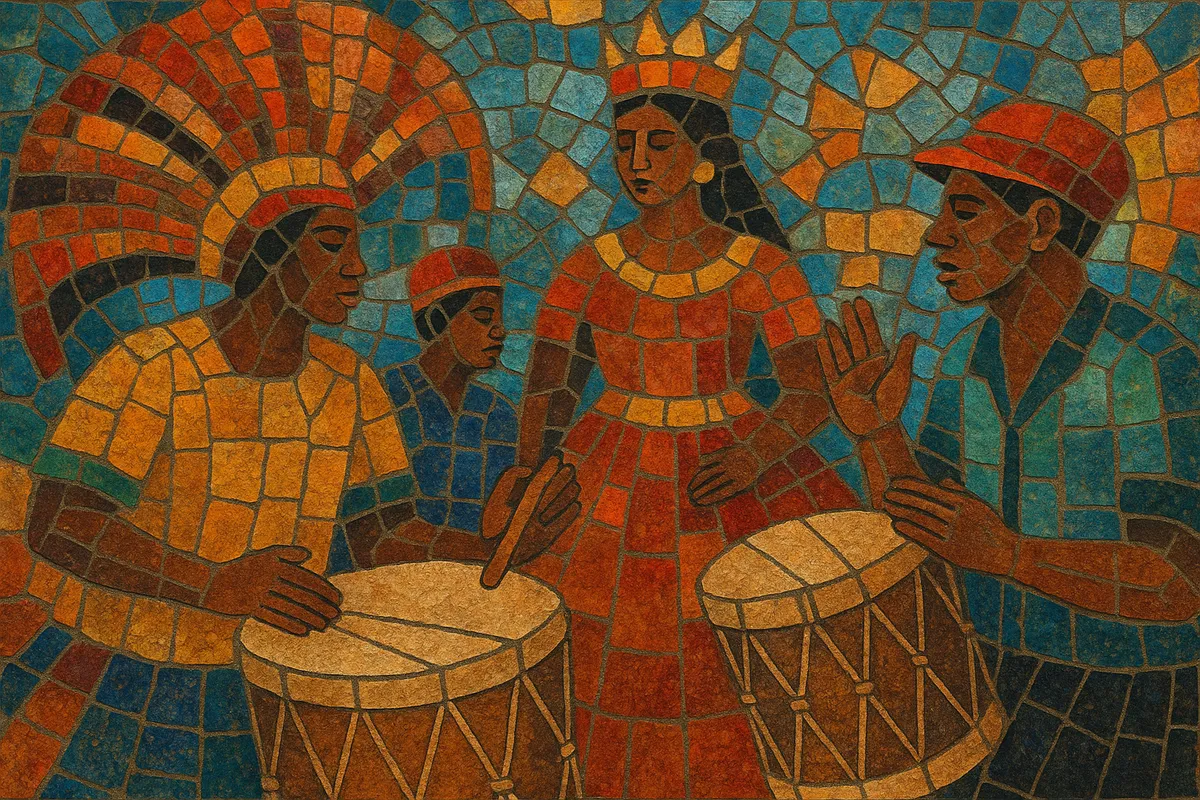Maracatu is an Afro-Brazilian processional music and performance tradition from Pernambuco, centered on powerful, polyrhythmic percussion and call-and-response song.
It exists in two main forms: Maracatu Nação (also called maracatu de baque virado), associated with the historic coronation ceremonies of the "Rei e Rainha do Congo" (King and Queen of Congo) in Recife and Olinda; and Maracatu Rural (maracatu de baque solto), linked to the sugarcane zone (Zona da Mata) and famous for its costumed caboclos de lança. Both forms combine African-derived drumming, Portuguese processional pageantry, and local popular poetry to create an epic, ceremonial groove that animates Carnival and community celebrations.
The core sound is driven by alfaias (large rope-tuned bass drums), caixas/tarois (snares), gonguê (iron bell), agbês/xequerês (gourd shakers), and ganzás/mineiros (metal shakers). Vocals are led by a puxador (lead singer) with a chorus, delivering toadas (songs) that praise the nation, invoke spiritual lineages, and comment on community life.
Maracatu emerged in the 1700s in Pernambuco, Brazil, among Afro-descendant brotherhoods that organized royal-style processions to crown symbolic “Kings and Queens of Congo.” These ceremonies blended Central and West African musical practices with Catholic confraternity rituals and Portuguese courtly pageantry. The music’s identity solidified around processional percussion led by alfaias, timeline patterns on the gonguê, and responsorial singing of toadas honoring the "nação" (nation) and its royalty.
By the late 19th and early 20th centuries, two related but distinct strands were recognized. Maracatu Nação (baque virado) developed in Recife–Olinda, closely tied to Afro-Brazilian religious houses and ceremonial aesthetics, with a characteristic "turned" (virado) drum phrase marking cadential turns. Maracatu Rural (baque solto) flourished in the Zona da Mata sugarcane region, incorporating rural poetics, brass and fife influences in some contexts, and the iconic caboclo de lança performers. Both styles share African-derived percussion and processional form, but differ in costume, singing style, and specific rhythmic phrasing.
Throughout the 20th century, nações such as Leão Coroado, Estrela Brilhante, Encanto do Pina, and Porto Rico carried maracatu through Carnival and community festivals. Masters (mestres) codified drum parts, calls, and repertoire, while local cultural institutions and Pernambuco’s Carnival elevated its profile. Field recordings, radio, and later television widened its reach, and documentation by scholars and activists helped safeguard repertories and practices.
In the 1990s, the Mangue Beat movement (e.g., Chico Science & Nação Zumbi) brought maracatu’s alfaias and gonguê into dialogue with rock, hip hop, and electronic textures, projecting the sound internationally. Workshops and community ensembles spread maracatu pedagogy across Brazil and abroad, while traditional nações continue to lead processions and competitions. Today, maracatu remains both a living Afro-Brazilian heritage and a fertile source for fusion in popular and experimental music.


